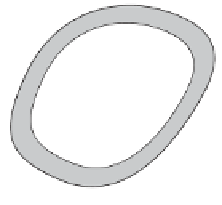Geoscience Reference
In-Depth Information
d
B
A
Figure 4.8
Closed system and open system. If we imagine that during a metamorphic perturbation an
element has moved an average distance
d
, small systems (minerals A) will be “opened” much
more intensely than large ones (large sample B), where only the outer skin will have exchanged
with the ambient medium. The shaded area represents the material involved in exchange outside
the system.
Samples, for example basalts extracted from a single source in the mantle, that formed
at
t
with the same (
143
Nd /
144
Nd)
0
ratio but with different
147
Sm/
144
Nd ratios, presum-
ably by different degrees of melting, will form an alignment known as the isochron
(
Fig. 4.3
), whose slope gives the age of formation. It is commonly held that, for the
isochron to be valid, the rocks must be “co-genetic” and the initial isotopic homogeneity
must be perfect. However, as a result of improved analytical techniques and instrumen-
tation, there is always an achievable level of precision for which the assumption of
initial isotopic homogeneity breaks down. A less conservative, but more realistic, state-
ment is that the initial isotopic variability must remain negligible compared with that
related to the accumulation of radiogenic nuclides: this explains why isochrons of old
age, such as those obtained from meteorites or lunar rocks, “look” better than those
from recent granites, or why isochrons of reasonable age can be obtained from samples
that are not necessarily taken from a homogeneous medium, such as sedimentary sample
suites.
Let us look at the problem of how the isochron withstands subsequent perturbations of
the closed-system regime. Let us imagine, for example, a series of basalts formed from a
single mantle source in Archean time, some 2.7 billion years ago, and subjected to intense
thermal perturbation when, caught up in the formation of a mountain belt some 600 million
years ago, they were transported to great depth and raised to temperatures of the order of
600-800
◦
C. Such metamorphism will create new minerals in basaltic rocks, probably an
assemblage of pyroxene and garnet known as eclogite. Suppose that a mean distance
d
can be defined over which the elements Sm and Nd migrate in the course of metamorphic
recrystallization, ranging probably from a fewmillimeters to a few centimeters (
Fig. 4.8
). If
our sample is very much smaller than
d
, we can presume that the exchanges of Sm and Nd
are complete and that the minerals, normally of very small size, will all have adopted the
ambient Nd isotopic composition, i.e. that of the rock at this location. If the sample size is
much greater than
d
, only the outer part over a depth
d
will have engaged in exchange with
the exterior. The interior will have been disturbed, but the exchanges will have remained
confined within the sample. If this open fringe represents only a small volume compared
with the bulk of the sample, it will be considered that the sample has not been affected by
the disturbance.


















